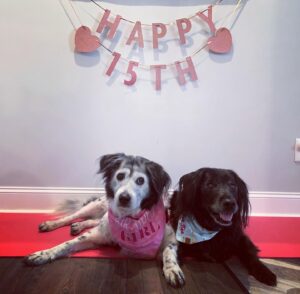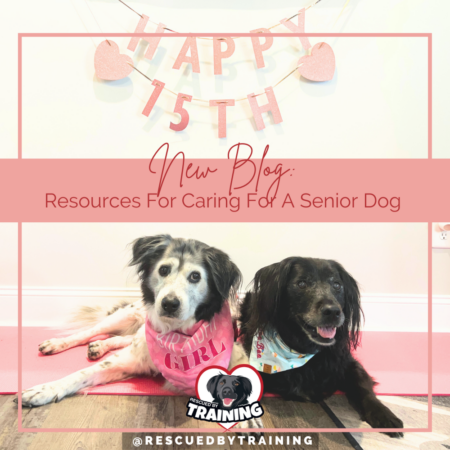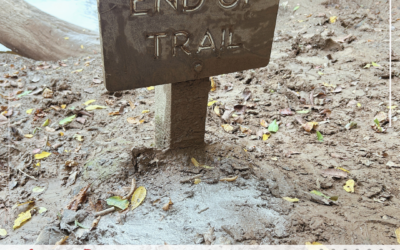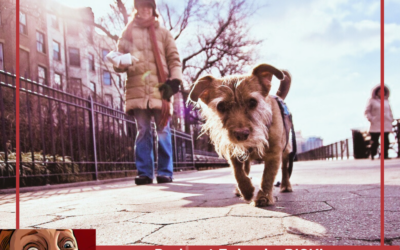Many of my friends with human kids love to say “don’t blink” meaning that if you blink you will miss your kids growing up and they will be gone, off on their own. This sentiment resonated with me even more for our dogs, who are with us for such a short period of time. Sharing my life with seniors these last several years, this point has really sunk in even more.
Senior dogs are close to my heart. Last year we said good-bye to Mr. Barbo at 14 years old and today is BooBoo’s 15th birthday! If you don’t know already, Boo is the reason I’m a trainer and why I do what I do. You can read our story here. I’ve written in the past about the risk of caregiver burnout, the connection between physical and behavioral health, and compiled a list of grief resources for the inevitable. I’ve also been inspired to learn more about arthritis, completing a canine arthritis course and most recently, becoming a certified end of life death doula for companion animals.
 As we are celebrating Boo’s 15th birthday, I’m keenly aware our time is limited. Her and her sister Sassy are the last two remaining from her litter. Their 3 brothers have all passed away over the last year. (Picture from when Sassy visited a couple of months ago and we had a pre-birthday celebration.)
As we are celebrating Boo’s 15th birthday, I’m keenly aware our time is limited. Her and her sister Sassy are the last two remaining from her litter. Their 3 brothers have all passed away over the last year. (Picture from when Sassy visited a couple of months ago and we had a pre-birthday celebration.)
Boo has her own health concerns, mild considering her age, notably chronic high liver values, but her recent ultrasound (her 3rd in the last 2 years) is completely “unremarkable.” She’s happy and eager for adventures but is obviously slowing down. She sleeps hard now that she’s lost her hearing. Her eating schedule is shifted. She needs pain medication to help with her joints more. She’s getting laser therapy several times a week.
But for a 15 year old dog, our vet says “she’s in pretty dang good shape!” She still does her “victory roll” after a good meal and loves a good roll in the grass when it’s warm out. When we went away a few months ago, she hiked over 27 miles with us in a week. They weren’t rigorous hikes and we were careful to ensure she wasn’t being asked to do more than she could and she was medicated well. We all had a wonderful time but even just these few months later, I’m not sure she could still do it.
Living with a senior dog is simultaneously full of joys and heartbreak. We know we are so lucky to have her into this stage of life – many others aren’t as fortunate. But it’s painful to watch her age, to get more gray specks in her face, to know she can’t hear me when I tell her how much I love her and to have moments of tears when I think about how short our time left probably is. And every time she skips a meal or isn’t feeling well, I can’t help but to think “is this the end?”
But today is a day for celebration, not sadness! And I wanted to share resources and things I’ve done that have been helpful for me through this journey through caring for seniors.
16 Recommendations For Giving Your Senior Dog The Best Remaining Life Possible:
- Protect them and keep them safe and happy. This is always my number one priority. Always. No exceptions.
- Medication and vet care. Trust your vet. Work with them for solid palliative care. Real meds that will help keep your dog comfortable and give them a good quality of life, for as long as that is. In late seniorhood, it’s about quality, not quantity. Focus on immediate pain and comfort – physical and emotional. Increase the frequency of your vet visits. We do blood work every 6 months at a minimum.
- Mobile vet. Consider a mobile vet to reduce anxiety and slippery floors in a clinic. And, when the time comes, the vet your dog is already comfortable with at home, can come do your at home euthanasia. When we euthanized Barbo last year, it was peaceful and stress-free for him.
- Plan and prepare. Nobody wants to think about their beloved dying, but planning ahead and figuring out what you’re willing to do and not do can give you a sense of control. And it can prevent suffering for your loved one. Download my Advance Care Directive to start the conversation with your family.
- Environmental/household changes. Add carpet runners or yoga mats on slippery floors. Use baby gates so they don’t go up and down the stairs unattended. Minimize stairs as much as possible. Feed on a washable rug to give traction when eating or doing enrichment.
- Resting surfaces. Lots of comfy, easy to get on/off of resting surfaces. Orthopedic (Big Barker!) or raised beds can make it easier for arthritic dogs to get off, since they’re raised up a bit and can slide or step into standing position without have to push themselves up so much.
- Alternative treatments. Use your pharmaceutical meds as your primary line of action but consider alternative treatments that can supplement. Laser, acupuncture, physical therapy, hydrotherapy, massage, body awareness, electrotherapy (therapeutic ultrasound) and thermo or crypto therapy.
- Adjusting expectations. It’s hard to accept but we need to adjust our expectations of what our seniors can comfortably do.
- Careful interactions with other dogs. Any interactions with dogs, especially unknown ones, are very carefully controlled. No puppies. Puppies are cute and rambunctious but they often jump on other dogs and with senior dogs having arthritis and weakness, this can be a disaster. We walk where leashes are required and I am extremely proactive about any off-leash dogs. I do not want an off leash dog, even if friendly, rushing up and accidentally knocking her over or trying to play.
- Grooming. It’s especially important to maintain proper nail length and trim the fur between toes and pads, so they have the best traction possible and so they’re not overcompensating and shifting their weight or walking with an odd gait because of instability.
- Gear. We use a Ruffwear harness that doesn’t require lifting up front legs to put the harness on and that has a lift handle that we can use to stabilize or help lift into and out of the car.
- Enrichment. I’ve written about how enrichment isn’t optional. It’s about meeting needs. So beyond physical needs seniors have, we need to ensure that while they may not get as much physical exercise, we’re giving them other opportunities to use their skills. Do more low impact “sniffari” walks, snuffle mats, food puzzles and car rides.
- Snackies. At 15, there’s lots of free snackies (Chicken Chips aka dog crack) for being cute. Snacks are an everyday occurrence here, multiple times of day. Don’t expect them to work for it either. It’s perfectly acceptable and encouraged to give snacks without asking them to sit or do anything. Do you do a trick before allowing yourself to eat a cookie or have some chips?
- Time. Cherish every moment. Get on their level. Indulge them if they solicit attention. Enjoy every moment you can so you have those memories and little regret when they’re gone. You never will say when they’re gone, I wish I spent less time with my dog. While some people wait until they’ve received terminal news to make a doggy bucket list, we actively work to incorporate fun activities with Boo as much as we can every day. Outdoor dining, sitting in the yard, gentle walks with neighbors, car rides, farmers market outings, beach time.
- Book recommendation. It’s Never Long Enough: A practical guide to caring for your geriatric dog (Old Dog Care and Pet Loss)
- Arthritis/Mobility resource: Canine Arthritis Management – they have a bunch of free resources but I highly recommend their membership for access to a library of content.
- Be objective. It’s hard when it’s your dog and emotions are high. Doing monthly or quarterly quality of life checks using a QoL scale can help you detect changes and gives you a picture of things in black and white on paper to review. There are plenty of quality of life scales out there and I have some listed in my grief resources post here.
I’ll leave you with this video of Boo snorting and rolling around in the grass recently. I love seeing these simple joys in her.
If you are facing seniorhood and need help, I can guide you. Whether it’s behavior, training cooperative care for vetting or grooming or you’re looking for end-of-life doula support, you can schedule a session here.
Love to all the seniors and their caretakers.
![]()




